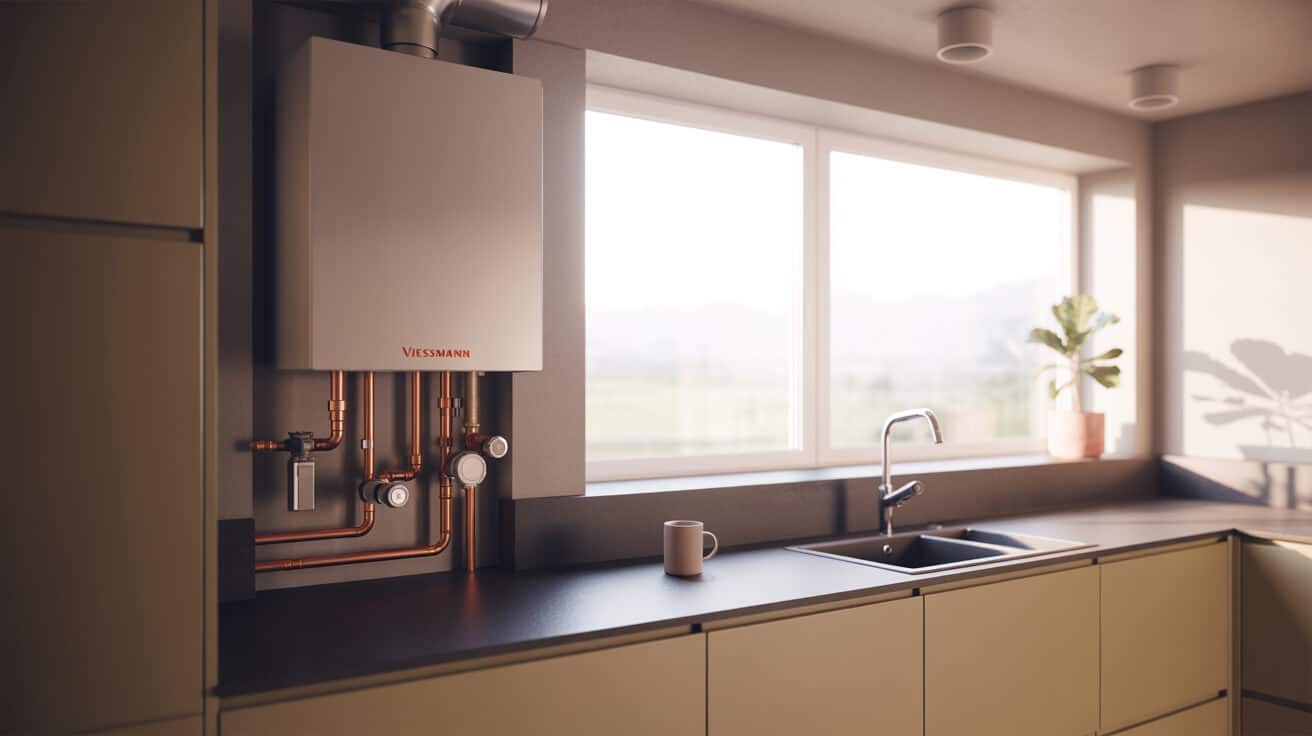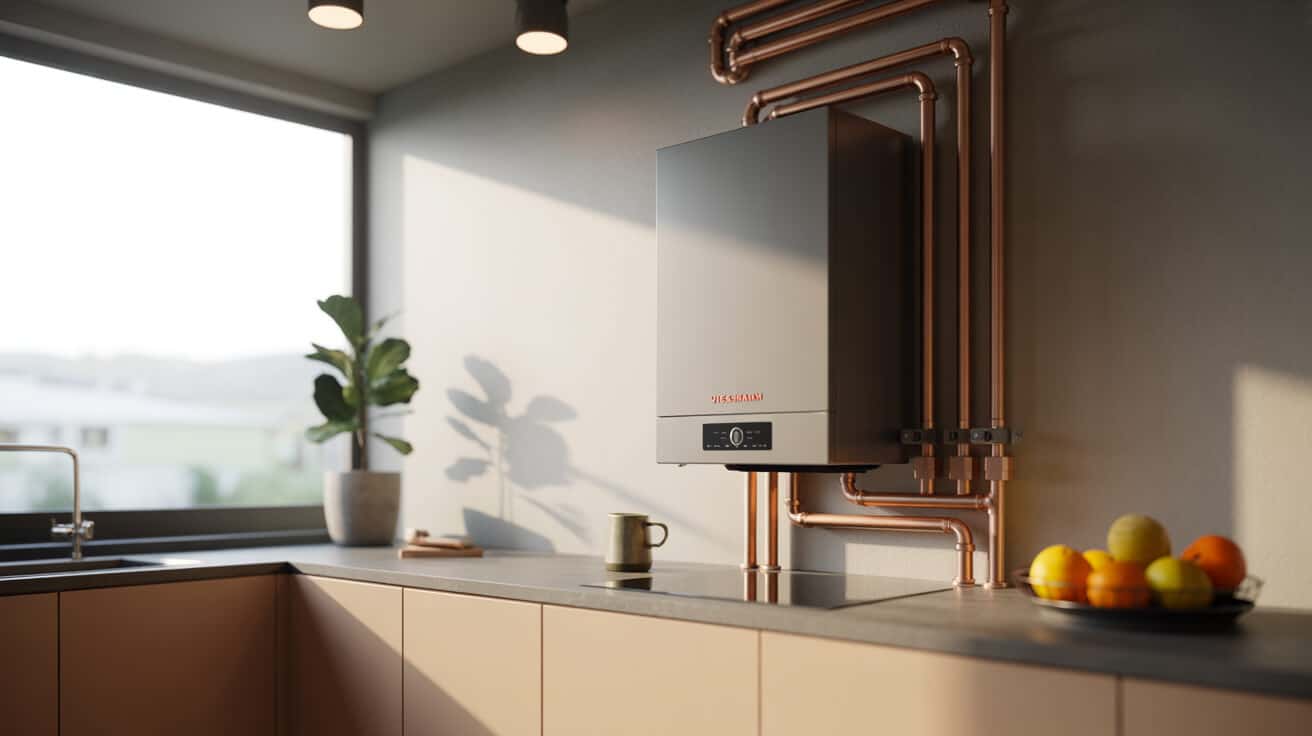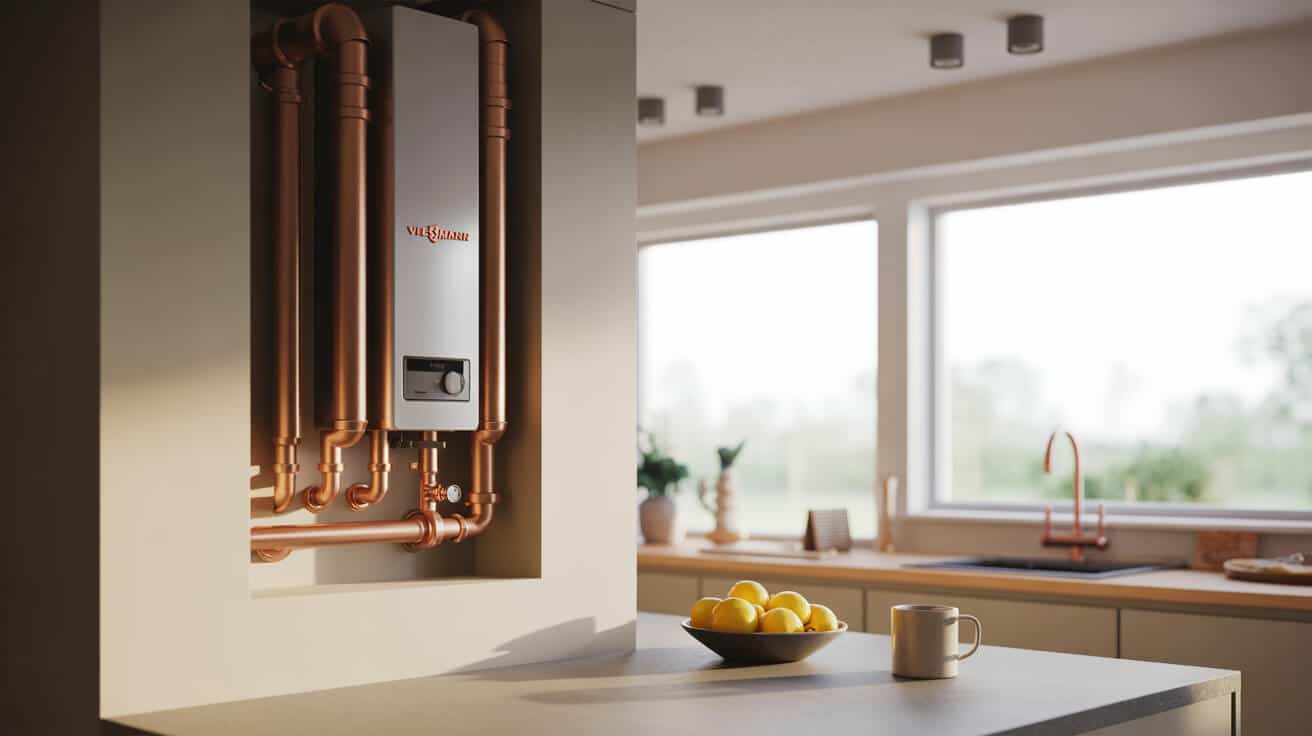Viessmann boilers, recognised for their precision engineering and adaptable system design, are central to the strategies employed by modern plumbing and heating companies. These boilers are selected for their compatibility with a wide variety of building types, from compact urban dwellings to expansive commercial properties. Featuring integrated digital controls, smart thermostat compatibility, and full compliance with national and European efficiency standards, Viessmann boilers support comfort, value retention, and regulatory obligations for both homeowners and commercial operators.
Etymology or Name Origin
Founded in 1917 by Johann Viessmann, the Viessmann Group retains the founder’s surname, preserving German industrial heritage and machine-age ambition within its corporate identity. Over more than a century of design, manufacturing, and research, the Viessmann name has become synonymous with high-quality heating technology. The brand’s German origin is frequently referenced as a marker of precision, reliability, and continued innovation in the global heating sector.
Overview / Context
Role within plumbing and heating companies
Plumbing and heating companies rely on Viessmann products due to their reliability, adaptability, and strong technical support structures. The brand’s portfolio includes solutions for varied property scales and system integrations, from single-family housing to large-scale commercial installations. Professionals appreciate the clarity of installation documentation, access to manufacturer-led training, and the rapid parts supply chain that enhances service efficiency.
Broader market setting
Viessmann operates in a competitive field, contending with brands such as Worcester Bosch, Vaillant, Ideal, and Baxi. Industry-wide trends—including aggressive decarbonization mandates, rising energy costs, and the demand for lifecycle value—drive innovation in condensing, hybrid, and hydrogen-ready boilers. The expansion of smart home connectivity and the increasing prevalence of grant-eligibility requirements for energy-efficient installations reinforce the relevance of Viessmann systems to both companies and end users.
Environmental and regulatory influence
The profound impact of environmental strategy and compliance requirements on boiler development and deployment has fueled Viessmann’s focus on condensing and low-emission technologies. Product ranges maintain full conformity with UK Building Regulations, the Gas Safety (Installation and Use) Regulations 1998, ErP (Energy-related Products) labelling, and Water Regulations Advisory Scheme (WRAS) components certification. For property managers and forward-looking organisations, these factors directly link heating equipment decisions to risk mitigation and long-term sustainability objectives.
History
Origins
Viessmann’s initial growth stemmed from supplying steel boilers to emerging urban centres in early twentieth-century Germany. The company’s earliest successes were rooted in manufacturing robust heat sources for small and mid-sized commercial properties.
Industrial emergence
As the use of oil and natural gas proliferated during the mid-twentieth century, Viessmann rapidly diversified its offerings. The evolution towards modularity and application-specific flexibility enabled widespread adoption in both public and private sector projects. Attention to operational safety, reliability, and ongoing service simplified adoption among professional engineer communities.
Contemporary evolution
During the late twentieth and early twenty-first centuries, Viessmann was among the first to commercialise condensing technology that recaptures waste heat, driving the leap beyond traditional “open vent” or non-condensing heating. Digitalization, smart controls (including the ViCare app), remote diagnostics, weather compensation, and, most recently, the introduction of hydrogen-blend-compatible models, highlight Viessmann’s adaptation to the evolving regulatory and environmental landscape. The continued partnership with installer networks and the proliferation of training centres underscore the company’s commitment to professional development and market relevance.

Concept / Description
Core principles
A Viessmann condensing boiler works by extracting and redeploying latent heat from combustion exhaust, using a stainless steel heat exchanger for efficiency gains that typically exceed 92%. The inclusion of modulating burners allows for precise fuel metering, directly aligning output to system demand, which extends equipment lifespan and dramatically reduces both operational noise and wasted energy.
Main components
Core components include:
- Primary heat exchanger: Typically manufactured from stainless steel, maximising conductivity and resistance to corrosion.
- Modulating pre-mix burner: Controls flame size to match heating requirements.
- Factory-integrated pump: Maintains optimal flow rate through heating circuits.
- Expansion vessel: Absorbs pressure changes, protecting system integrity.
- Control circuitry: Embedded microprocessor, with safety interlocks, error logging, and digital modulation algorithms.
- Sensors: Multiple temperature, pressure, and flow sensors ensure safety and efficiency.
Digital control and smart features
Viessmann boilers offer interfaces compatible with OpenTherm-enabled thermostats, weather compensation sensors, and a rich suite of digital controllers. The ViCare app provides homeowners and property managers with remote visibility, troubleshooting support, and, in some models, predictive maintenance alerts. These tools decrease unplanned downtime and increase long-term operating efficiency.
Safety mechanisms
Automated and redundant safety features include:
- Pressure relief valves
- Anti-frost cycles
- Continuous monitoring for blocked flues and ignition errors
- Error code output on the main control panel
- Smart shutoff protocols
Integration of these features ensures installation within UK regulatory context and instils confidence for landlords and building managers tasked with tenant safety.
Functionality / Purpose / Applications
Principal functions
Viessmann boilers deliver space heating and domestic hot water, serving as the foundation for modern hydronic heating systems. Their adaptability extends across housing, retail, healthcare, hospitality, and educational facilities.
Domestic applications
For individual homeowners, these boilers translate to lower fuel bills, faster hot water delivery, and improved environmental credentials for your property. System flexibility accommodates underfloor heating, complex zoning, and large-volume domestic hot water storage, allowing tailored operation for both upgrades and new builds.
Commercial and multi-occupancy applications
Facilities managers, housing associations, and office administrators often select Viessmann for high-demand, multi-appliance heat delivery. Features such as cascade operation (multiple boilers managed as a single “plant”), direct BEMS integration, noise control enhancements, and service port accessibility all contribute to minimal disruption and rapid troubleshooting for your company or managed estate.
Controls and optimization
The range of user interfaces—from tactile dials through advanced touchscreen panels—enables effective operation regardless of technical proficiency. For professional managers or engineers, app-based configuration and web dashboards enable property-wide heating monitoring and adjustment, maximising both comfort and cost control.
Classifications / Types / Variants
Main types
- Combination (combi) boilers: – Provide instantaneous heating and hot water without the need for separate storage, ideal for space-constrained or smaller properties.
- System boilers: – Work with unvented hot water cylinders, suitable for properties with higher domestic hot water demand or multiple bathrooms.
- Regular (heat-only) boilers: – Interface with traditional gravity-fed systems, often chosen for properties with legacy pipework or large heat distribution networks.
Model distinctions
Table: Main Viessmann Model Families
| Model | Main Use | Capacity Range (kW) | Key Distinction |
|---|---|---|---|
| Vitodens 050-W | Domestic | 19–35 | Entry-level, combi/system |
| Vitodens 100-W | Domestic/Light Comm. | 19–35 | Quiet operation, touchscreen |
| Vitodens 111-W | Domestic | 25–35 | Integral storage combi |
| Vitodens 200-W | Domestic/Commercial | 19–150 | Advanced controls, cascade |
| Vitocrossal | Commercial | Up to 1,000+ | Cascade plant, commercial |
| Hydrogen-ready | All | Model dependent | H2 blend compatible |
Comparative factors
Selection is driven by modulation range, hot water flow rate, warranty terms, digital capabilities, and compatibility with renewable energy. Plumbing companies often match Viessmann units to bespoke control solutions and system retrofits, optimising for both performance and end-user simplicity.
Systems / Tools / Methodologies
System design principles
Best-practice installation by certified companies begins with a heat loss survey and full-site analysis. Proper siting of the unit (e.g., avoiding frost-prone zones, ensuring flue clearance, and providing maintenance access) is critical for both optimal operation and code compliance.
Common and specialised tools
Installers utilise:
- Gas pipe sizing calculators
- Flue gas analyzers
- Digital manometers
- Pipe press tools and crimpers
- Wireless diagnostic kits
- Combustion controls software
Powerflush machines are used to cleanse legacy systems, removing sludge and extending new equipment lifespan.
Diagnostic methods
Annual and ad hoc checks include:
- Central unit code reading
- Burner and ignition tests
- Pressure stabilisation
- Heat exchanger inspection (thermal camera where applicable)
- Water quality and inhibitor level validation
For landlords, digital diagnostic records from your company serve as valuable proof for compliance and warranty retainment.

Stakeholders / Entities Involved
Main stakeholders
- Homeowners: Responsible for scheduling maintenance, adjusting controls, and monitoring efficiency.
- Landlords and property managers: Accountable for legal compliance, service documentation, and timely repairs.
- Facility managers: Oversee installation, user training, and ensure property-wide standardisation in large developments.
- Installers/Engineers: Gas Safe-registered professionals authorised to specify, fit, and commission Viessmann boilers.
- Manufacturer and suppliers: Viessmann oversees R&D, warranty, and technical support. Distributors stock parts and facilitate rapid order-fulfilment for your service providers.
Lifecycle roles
Each product transitions from manufacturing to supplier, installer, operator, and finally to your service provider for maintenance or replacement. Certified companies such as Plumbers 4U facilitate this lifecycle efficiently, maintaining a documented chain for regulatory confidence and warranty longevity.
Regulatory bodies
Influence stems from the Gas Safe Register (installer certifications), Building Regulations authorities (compliance and inspection), WRAS (water fittings), and ErP (efficiency standards).
Legal / Regulatory / Ethical Considerations
Certification and installation requirements
All gas boilers must be installed by Gas Safe-registered personnel. Direct compliance with Building Regulations, including Part L (energy efficiency) and Part G (water temperature and supply), is verified on site and by council notification where required. WRAS-approved components guarantee legal water supply integration.
Grant and incentive eligibility
Eligible properties may access grants through Boiler Upgrade Scheme (BUS) or ECO4 when replacing non-compliant or inefficient systems with Viessmann’s high-performance, hydrogen-ready models. Documentation and procedural accuracy by your plumber or heating company, such as Plumbers 4U, are typically prerequisites for grant approval.
Documentation, warranty, and ethical operation
Proper commissioning, logbooks, and digital documentation preserve warranty integrity. Ethical obligations demand transparent communication to your property, especially when safety-critical issues (e.g., carbon monoxide alarms, system leaks) arise. Routine checks align with both legal statutes and ethical best practice for occupant care.
Performance Metrics / Data / Measurements
Efficiency measures
Modern Viessmann boilers consistently achieve ErP ratings of A or above, with SEDBUK figures ranging from 89% to 98% dependent on model, controls, and installation context. Detailed system monitoring allows for ongoing high performance, with efficiency curves tailored to your property’s demand shape.
Maintenance and service
Service schemes mandate annual checks, many of which can be performed rapidly using manufacturer diagnostics and digital tools. Key data points include flue gas composition, ignition function, combustion efficiency, and pressure stability. Records from your installer help ensure compliance with warranty and regulatory obligations.
Warranty periods and measurement
Warranties typically run five to twelve years, contingent on product registration and regular servicing by an approved provider. Measurement of system health involves regular verification of safety devices, leakage checks, and electronics health.
Table: Key Performance Data Points
| Metric | Typical Rating/Requirement |
|---|---|
| ErP Boiler Efficiency | A (≥ 92%) |
| SEDBUK Rating | 89–98% |
| Warranty Duration | 5–12 years |
| Recommended Service Interval | 12 months |
| Hydrogen-readiness | Yes (select models) |
Challenges / Barriers / Limitations
Operational barriers
Retrofitting to existing systems can require significant adaptation—pipe rerouting, flue repositioning, or upgraded power supply. Your property may also demand architectural or engineering modifications to comply with current codes and manufacturer clearances.
Common technical issues
Frequent service situations include pressure loss, ignition and sensor errors (F codes), scale or debris build-up within exchanger, and zone valve malfunctions. Most can be preempted or resolved by your professional plumber using manufacturer diagnostics and genuine parts.
Economic barriers
While Viessmann boilers often command a premium price, reduced running costs, lower service frequency, and longer life cycles contribute to overall value in your property or facility. For property managers, capital grants and service-level agreements offset some financial obstacles.
Social and policy constraints
Tenant safety and comfort are subject to regulatory expectation, especially in multi-let or vulnerable occupancy sectors. Legislative shifts—grant schemes, emissions taxes, Minimum Energy Efficiency Standards—impose evolving requirements on property managers and organisations.
Impact / Influence / Legacy
Industry contributions
Viessmann’s introduction of stainless steel condensing technology, modular design, and smart platform integration has changed industry benchmarks, promoting scalable, maintainable, and energy-efficient heating systems.
Policy and decarbonisation
Market adoption has accelerated compliance with national and regional energy performance goals, with a measurable effect on the carbon footprint of managed estates and individual homes. Flexible integration capacity—solar heating, heat pumps, weather compensation—amplifies decarbonization potential.
Professional and user legacy
Long-standing relationships with both independent engineers and major property operators validate the brand’s influence. Installer networks such as Plumbers 4U anchor ongoing customer confidence with access to direct training, genuine spares, and warranty management.
Future directions, cultural relevance, and design discourse
Ongoing research into hydrogen as a mainstream heating fuel signals further shifts toward ultra-low-carbon systems. Buyers and managers increasingly expect not just functional performance, but also predictive diagnostics, effortless user interfaces, quiet operation, and compatibility with evolving connected-home infrastructure. Emerging design standards reflect heating’s rising profile in sustainable design and social discourse, positioning Viessmann boilers as a durable, adaptive core of the 21st-century built environment.

